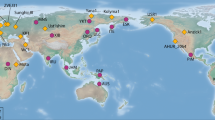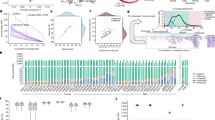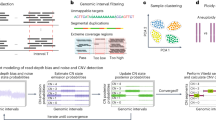Abstract
Most genomic variation is attributable to single nucleotide polymorphisms (SNPs), which therefore offer the highest resolution for tracking disease genes and population history1,2,3. It has been proposed that a dense map of 30,000–500,000 SNPs can be used to scan the human genome for haplotypes associated with common diseases4,5,6. Here we describe a simple but powerful method, called reduced representation shotgun (RRS) sequencing, for creating SNP maps. RRS re-samples specific subsets of the genome from several individuals, and compares the resulting sequences using a highly accurate SNP detection algorithm. The method can be extended by alignment to available genome sequence, increasing the yield of SNPs and providing map positions. These methods are being used by The SNP Consortium, an international collaboration of academic centres, pharmaceutical companies and a private foundation, to discover and release at least 300,000 human SNPs. We have discovered 47,172 human SNPs by RRS, and in total the Consortium has identified 148,459 SNPs. More broadly, RRS facilitates the rapid, inexpensive construction of SNP maps in biomedically and agriculturally important species. SNPs discovered by RRS also offer unique advantages for large-scale genotyping.
This is a preview of subscription content, access via your institution
Access options
Subscribe to this journal
Receive 51 print issues and online access
$199.00 per year
only $3.90 per issue
Buy this article
- Purchase on SpringerLink
- Instant access to full article PDF
Prices may be subject to local taxes which are calculated during checkout


Similar content being viewed by others
References
Lander, E. S. The new genomics: global views of biology. Science 274, 536–539 (1996).
Collins, F. S., Guyer, M. S. & Chakravarti, A. Variations on a theme: cataloging human DNA sequence variation. Science 278, 1580– 1581 (1997).
Risch, N. & Merikangas, K. The future of genetic studies of complex human diseases. Science 273, 1516–1517 (1996).
Hastbacka, J. et al. Linkage disequilibrium mapping in isolated founder populations: diastrophic dysplasia in Finland. Nature Genet. 2, 204–211 (1992); erratum ibid. 2, 343 (1992).
Kruglyak, L. Prospects for whole-genome linkage disequilibrium mapping of common disease genes. Nature Genet. 22, 139– 144 (1999).
Collins, A., Lonjou, C. & Morton, N. E. Genetic epidemiology of single-nucleotide polymorphisms. Proc. Natl Acad. Sci. USA 96, 15173– 15177 (1999).
Weber, J. L. & Myers, E. W. Human whole-genome shotgun sequencing. Genome Res. 7, 401–409 (1997).
Ewing, B. & Green, P. Base-calling of automated sequencer traces using PHRED. II. Error probabilities. Genome Res. 8, 186–194 (1998).
Ewing, B., Hillier, L., Wendl, M. C. & Green, P. Base-calling of automated sequencer traces using PHRED. I. Accuracy assessment. Genome Res. 8, 175–185 (1998).
Gu, Z., Hillier, L. & Kwok, P. Y. Single nucleotide polymorphism hunting in cyberspace. Hum. Mutat. 12, 221–225 (1998).
Marth, G. T. et al. A general approach to single-nucleotide polymorphism discovery. Nature Genet. 23, 452– 456 (1999).
Buetow, K. H., Edmonson, M. N. & Cassidy, A. B. Reliable identification of large numbers of candidate SNPs from public EST data. Nature Genet. 21, 323–325 (1999).
Cargill, M. et al. Characterization of single-nucleotide polymorphisms in coding regions of human genes. Nature Genet. 22, 231–238 (1999).
Wang, D. G. et al. Large-scale identification, mapping, and genotyping of single-nucleotide polymorphisms in the human genome. Science 280, 1077–1082 (1998).
Halushka, M. K. et al. Patterns of single-nucleotide polymorphisms in candidate genes for blood-pressure homeostasis. Nature Genet. 22, 239–247 (1999).
Li, W. H. & Sadler, L. A. Low nucleotide diversity in man. Genetics 129, 513–523 (1991).
Mullikin, J. C. et al. An SNP map of human chromosome 22. Nature 407, 516–523 (2000).
Collins, F. S., Brooks, L. D. & Chakravarti, A. A DNA polymorphism discovery resource for research on human genetic variation. Genome Res. 8, 1229–1231 (1998).
Landegren, U., Nilsson, M. & Kwok, P. Y. Reading bits of genetic information: methods for single-nucleotide polymorphism analysis. Genome Res. 8, 769 –776 (1998).
Altschul, S. F., Gish, W., Miller, W., Myers, E. W. & Lipman, D. J. Basic local alignment search tool. J. Mol. Biol. 215, 403–410 (1990).
Cambien, F. et al. Sequence diversity in 36 candidate genes for cardiovascular disorders. Am. J. Hum. Genet. 65, 183– 191 (1999).
Li, W. -H. Molecular Evolution (Sinauer Associates, Canada, 1997 ).
Acknowledgements
We are indebted to the staff of the Whitehead Institute/MIT Center for Genome Research Sequencing Center for high-throughput sequencing and to N. Stange-Thomann for contributions to library construction. We would like to thank B. Blumenstiel and R. Lane for library construction and SNP validation, and M. Molla, L. Friedland, J. Ireland and B. Gilman for informatics assistance. We appreciate helpful discussions with members of The SNP Consortium, as well as colleagues at the Whitehead/MIT Genome Center. D.A. is a recipient of a Howard Hughes Medical Institute Postdoctoral Fellowship for Physicians. C.R.C. is supported by the Cancer Research Fund of the Damon Runyon / Walter Winchell Foundation. This work was conducted under grants from the Wellcome Trust and The SNP Consortium to E.S.L.
Author information
Authors and Affiliations
Corresponding author
Rights and permissions
About this article
Cite this article
Altshuler, D., Pollara, V., Cowles, C. et al. An SNP map of the human genome generated by reduced representation shotgun sequencing. Nature 407, 513–516 (2000). https://doi.org/10.1038/35035083
Received:
Accepted:
Issue Date:
DOI: https://doi.org/10.1038/35035083
This article is cited by
-
Conservation genomics of the threatened Trispot Darter (Etheostoma trisella)
Conservation Genetics (2024)
-
Genetic dissection of fruit maturity date in apricot (P. armeniaca L.) through a Single Primer Enrichment Technology (SPET) approach
BMC Genomics (2022)
-
Genetic diversity and population structure of Caryopteris mongholica revealed by reduced representation sequencing
BMC Plant Biology (2022)
-
Genome-wide SSR markers in bottle gourd: development, characterization, utilization in assessment of genetic diversity of National Genebank of India and synteny with other related cucurbits
Journal of Applied Genetics (2022)
-
Facilitating population genomics of non-model organisms through optimized experimental design for reduced representation sequencing
BMC Genomics (2021)



